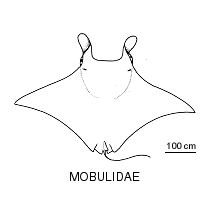- Classification
- CHONDRICHTHYES
- MYLIOBATIFORMES
- MOBULIDAE
-
Fish Classification
-
Class
CHONDRICHTHYES Sharks, rays ... -
Order
MYLIOBATIFORMES -
Family
MOBULIDAE Devil rays -
Genera
Mobula(6)
Family MOBULIDAE
More Info
|
Family Taxonomy |
Mobulids are currently considered to belong to one of two genera: Manta (two species) and Mobula (nine species). Characters that have been used to separate the groups include the fact that mantas have a terminal mouth, while themouth of mobulas is on the underside of the head. Mantas also lack teeth on the upper jaw. However, a number of authors in the pasat have suggest that the genus Mobula is not natural grouping - and recent genetic evidence suggests that the Manta genus is nested within Mobula. |
|
Family Conservation |
Manta and mobula rays are threatened by a number of factors including bycatch in non-target fisheries, boat strikes and bycatch in nets. However, the greatest threat is being targeted in fisheries for their meat and skin - and a growing demand for their gill rakers which are used traditional Chinese medicine. |
|
Author |
Bray, D.J. 2018 |
|
Family Resources |
|
References
Adneti, S., H. Cappetta, G. Guinoti & G. Notarbartolo di Sciara. 2012. Evolutionary history of the devilrays (Chondrichthyes: Myliobatiformes) from fossil and morphological inference. Zoological Journal of the Linnean Society 166: 132–159.
Couturier L.I.E., Marshall A.D., Jaine F.R.A., Kashiwagi T., Pierce S.J., Townsend K.A., Weeks S.J., Bennett M.B. & Richardson A.J. (2012) Biology, ecology and conservation of mobulid rays, the Mobulidae (Gill 1893). Journal of Fish Biology 80: 1075-1119.
González-Isáis, M. & Domínguez, H.M.M. 2004. Comparative anatomy of the superfamily Myliobatoidea (Chondrichthyes) with some comments on phylogeny. Journal of Morphology262: 517-535
Heinrichs S, O’Malley M, Medd HB, Hilton P (2011). The Global Threat to Manta and Mobula Rays. Manta Ray of Hope. http://www.mantarayofhope.com/downloads/The-Global-Threat-to-Manta-and-Mobula-Rays.pdf. Accessed 12 August 2012.
Kashiwagi T, Marshall AD, Bennett MB, Ovenden JR. 2012. The genetic signature of recent speciation in manta rays (Manta alfredi and M. birostris).Molecular Phylogenetics and Evolution64: 212–218.
Last, P.R. & Stevens, J.D. 2009. Sharks and Rays of Australia. 2nd edition. Canberra : CSIRO Australia 644 pp. 91 pls figs
Marshall, A.D, Compagno, L.J.V. & Bennett, M.B. 2009. Redescription of the genus Manta with resurrection ofManta alfredi (Krefft, 1868) (Chondrichthyes; Myliobatoidei; Mobulidae). Zootaxa 2301: 1-28
Marshall AD, Pierce SJ, Bennett MB. 2008. Morphological measurements of manta rays (Manta birostris) with a description of a foetus from the east coast of Southern Africa. Zootaxa 1717: 24–30.
Naylor GJP, Caira JN, Jensen K, Rosana KAM, Straube N, Lakner C (2012) Elasmobranch phylogeny: a mitochondrial estimate based on 595 species. In: Carrier JC, Musick JA, Heithaus MR (eds) Biology of sharks and their relatives, 2nd edn. CRC Press, Boca Raton, Florida, pp 31-56
Nelson, J.S. 2006. Fishes of the World. Hoboken, New Jersey : John Wiley & Sons, Inc. 601 pp. [in the family Myliobatidae]
Notarbartolo-di-Sciara, G. 1987. A revisionary study of the genus MobulaRafinesque, 1810 (Chondrichthyes: Mobulidae) with the description of a new species. Journal of the Linnean Society of London, Zoology 91(1): 1-91.
O’Malley MP, Lee-Brooks K, Medd HB (2013) The Global Economic Impact of Manta Ray Watching Tourism. PLoS ONE 8(5): e65051. doi:10.1371/journal.pone.0065051
Paig-Tran, E.W.M., Kleinteich, T. & Summers, A.P. (2013). The filter pads and filtration mechanisms of the devil rays: variation at macro and microscopic scales (Manta Walbaum 1792 and Mobula Rafinesque 1810). J. Morph. 274(7): 1026-1043. doi: 10.1002/jmor.20160 Abstract
Poortvliet, M., Olsen, J., Croll, D., Bernardi, G., Newton, K., Kollias, S., O’Sullivan, J., Fernando, D., Stevens, G., Galván-Magaña, F., Seret, B., Wintner, S. & Hoarau, G. 2014. A dated molecular phylogeny of manta and devil rays (Mobulidae) based on mitogenome and nuclear sequences. Molecular phylogenetics and evolution 83. 10.1016/j.ympev.2014.10.012.
Stevens, G. 2011. Field Guide to the Identification of Mobulid Rays (Mobulidae): Indo-West Pacific. Manta Trust. www.mantatrust.org 19 p. PDF
White, W.T., Corrigan, S., Yang, L., Henderson, A.C., Bazinet, A.L., Swofford, D.L. & Naylor, G.J.P. 2017. Phylogeny of the manta and devilrays (Chondrichthyes: mobulidae), with an updated taxonomic arrangement for the family. Zoological Journal of the Linnean Society 2017 zlx018. doi: 10.1093/zoolinnean/zlx018 Open access
White WT, Giles J, Dharmadi, Potter IC (2006) Data on the bycatch fishery and reproductive biology of mobulid rays (Myliobatiformes) in Indonesia. Fisheries Research 82(1-3): 65-73.




































